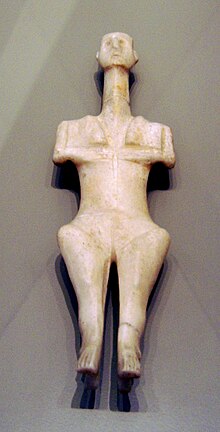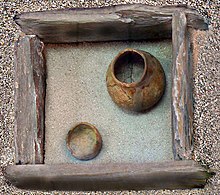Grotta Pelos culture
The Grotta Pelos culture is a prehistoric society on the Greek archipelago of the Cyclades . It begins in the Neolithic in the middle of the 4th millennium BC. And continues in the Bronze Age until about 2650 BC. Chr. Continued. It marks the beginning of the so-called Cycladic culture and is often equated with the relative phase Early Cycladic I (FK I). The culture was named by the British archaeologist Colin Renfrew after finding places in Grotta ( Greek Γρόττα ) on the island of Naxos and Pelos (Πηλός Pilos ) on Milos . Other finds from this culture were made elsewhere on the same island and in the lowest layer of the excavations at Phylakopi on Milos. By Christos Doumas the culture to one of the other localities on Naxos as is Pelos-Lakkoudes culture called.
buildings
Settlements from this period are hardly known, most of the findings come from excavations at necropolises . Remnants of walls have also been found at cemeteries that have been assigned to the culture through grave finds. In Ágii Anárgyri (Άγιοι Ανάργυροι) on Naxos an almost 40 m long and about 1 m high wall made of flat field stones from the island was excavated. The stones are piled up without binding agents and support the burial ground on a kind of terrace.
Originally it was assumed that residential buildings were either simple huts made of reed or that their flat foundations are no longer recognizable today due to erosion . Recent excavations since the 1990s, based on the remains of the wall, suggest that there were fortified settlements in Strofilas on Andros as early as the late Neolithic. Also in Markiani on Amorgos , walls in FK I have been dated, which were then used until the end of FK II. Further settlement remains from the Grotta Pelos culture were found in Skarkos on Ios .
Since the cemeteries only comprised 15–20 graves, it can be assumed that the people did not settle in villages, but families or clans lived in one or a few individual houses.

Graves
The graves themselves consist of erected flat stone slabs or small loose stone walls and usually contain only one corpse. Occasionally two to eight deceased were buried in a grave, which sometimes had two levels separated by a stone slab.
Grave goods were not contained in every grave. They mostly consist of ceramic vessels in the form of bowls or jugs made from the dark clay of the islands. The shapes are thick-walled and clumsy, decorations consist of painted spirals and (less often) geometric patterns. A few marble vessels are known.
In some graves, figures were also found made of marble, which are assigned to the type of the Cycladic idols. Three forms predominate: easily recognizable human forms of standing figures with hands touching their stomachs, strongly stylized human figures with short arms spread and thirdly abstract figures whose form is reminiscent of a violin .
Metals are very rare. A few pieces of copper wire, several awls made of the same material and a necklace with silver beads were found only in a cemetery on Naxos .
Culture
The main features of the Grotta Pelos culture correspond to the contemporary cultures on the Greek mainland, the island of Crete and especially in the construction of the tombs of the culture of Iasos on the west coast of Asia Minor . It is considered a further development of the settlement culture from Kephala to Kea, which was still part of the Neolithic Age .
More recent finds in the grave field of Grotta combine ceramic shards with white geometric painting and blades made of obsidian and are reminiscent of the Neolithic settlement of Saliagos . After this culture was already 3700 BC. BC, before the Grotta Pelos culture emerged in the middle of the 4th millennium, connections and cultural traditions are unknown.
literature
- Werner Ekschmitt : The Cyclades. Bronze Age, Geometric and Archaic Age . Verlag Philipp von Zabern , Mainz 1993, ISBN 3-8053-1533-3 .
- Colin Renfrew: The Emergence of Civilization. The Cyclades and the Aegean in the Third Millennium BC . Methuen, London 1972, ISBN 0-416-16480-3 .
Web links
- Dartmouth College: The Early Cycladic Period (English)
Individual evidence
- ↑ Clemens Lichter: Nothing comes from anything - Stone Age predecessors of the Cycladic culture . In: Claus Hattler (Ed.): Cyclades - Worlds of Life in an Early Greek Culture. Primus Verlag, Darmstadt 2011, ISBN 978-3-86312-016-0 , pp. 32-40, 37
- ↑ Stefanie Hubert: Hillside location and sea view - On early Cycladic house and settlement architecture . In: Claus Hattler (Ed.): Cyclades - Worlds of Life in an Early Greek Culture. Primus Verlag, Darmstadt 2011, ISBN 978-3-86312-016-0 , pp. 60–73, 60, 62
